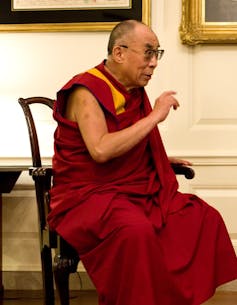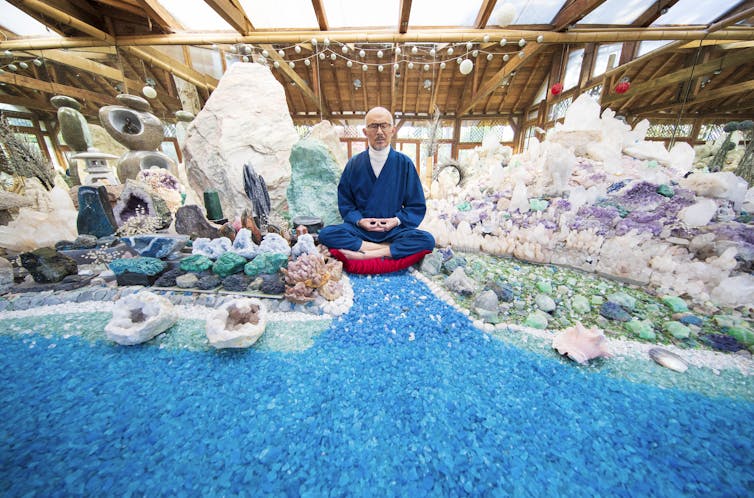A personal blog by a graying (mostly Anglo with light African-American roots) gay left leaning liberal progressive married college-educated Buddhist Baha'i BBC/NPR-listening Professor Emeritus now following the Dharma in Minas Gerais, Brasil.
Friday, September 4, 2020
Medicine Buddha Mantra
TAYATA, OM BEKADZE BEKADZE
MAHA BEKADZE BEKADZE,
RADZA SAMUNGATE
SOHA
This is pronounced:
Tie-ya-tar, om beck-and-zay beck-and-zay
ma-ha beck-and-zay beck-and-zay
run-zuh sum-oon-gut-eh
so-ha.
Via Daily Dharma: Being Truthful
There is an essential connection between truthfulness and personal integrity. If one goes, so will the other.
—Matthew Gindin, “What Did the Buddha Say About Lying?”
CLICK HERE TO READ THE FULL ARTICLE
Thursday, September 3, 2020
Via Daily Dharma: Identify with Consciousness
Suffering exists until we identify not with the changing conditions of our lives but with consciousness itself.
—Nina Wise, “Sudden Awakening”
CLICK HERE TO READ THE FULL ARTICLE
Wednesday, September 2, 2020
Via White Crane Institute // This Day in Gay History: JOHN M. MCNEILL
In 1988, he received a further order from Cardinal Ratzinger (soon to become Pope Benedict XVI, the first Pope to resign in a millennium) directing him to give up all ministry to Gay persons which he refused to do in conscience. As a result, he was expelled by the Vatican from the Society of Jesus (Jesuits) for challenging the teachings of the Roman Catholic Church on the issue of homosexuality, and for refusing to give up his ministry and psychotherapy practice to Gay men and Lesbians. McNeill had been a Jesuit for nearly 40 years.
After enlisting in the U.S. Army during World War II at the age of seventeen, McNeill served in combat in the Third Army under General Patton and was captured in Germany in 1944. McNeill spent six months as a POW (Prisoner of War) until he was liberated in May of 1945. John enrolled in Canisius College in Buffalo after his discharge from the army and, upon graduating, entered the Society of Jesus in 1948. He was ordained a Jesuit priest in 1959.
In 1964, McNeill earned a Doctorate in Philosophy, with highest honors (Plus Grande Distinction), at Louvain University in Belgium. His doctoral thesis on the philosophical and religious thought of Maurice Blondel was published in 1966 as the first volume of the series Studies in the History of Christian Thought edited by Heiko Oberman and published by Brill Press in Leyden, Holland.
During his professional career, McNeill taught philosophy at LeMoyne College in Syracuse, NY, and in the doctorate program at Fordham University in NYC. In 1972, he joined the combined Woodstock Jesuit Seminary and Union Theological Seminary faculty as professor of Christian Ethics, specializing in Sexual Ethics.
In 1974, McNeill was co-founder of the New York City chapter of Dignity, a group for Catholic Gays and Lesbians. For over twenty-five years, he has been active in a ministry to Gay Christians through retreats, workshops, lectures, publications, etc. For twenty years John was a leader of semiannual retreats at the Kirkridge Retreat Center in Pennsylvania.
Via Daily Dharma: Becoming Independent
By facing our internal conflicts, we learn to be strong, independent, and responsible for our own emotions.
—Dzogchen Ponlop Rinpoche, “The Wisdom of Emotions”
CLICK HERE TO READ THE FULL ARTICLE
Via Ram Dass - Love Serve Remember Foundation // Words of Wisdom - September 2, 2020 💌
One part of getting free, free into the soul or the witness, is the ability to stand back a little bit because now you are identified with being the witness rather than being the player, and thus you can see the play more clearly.
- Ram Dass -
Tuesday, September 1, 2020
Via Daily Dharma: Leveling the Ego
Sincere Zen practice is a mirror where attempts to inflate the ego are leveled again and again.
— Eido Frances Carney, “Zen and the Art of Begging”
CLICK HERE TO READ THE FULL ARTICLE
Monday, August 31, 2020
Via Mushim Patricia Ikeda
Via Daily Dharma: Healing Through Compassion
The
gateway to compassion and lovingkindness is to be able to feel our own
pain, and the pain of others. If we are able to open in this way, our
hearts can melt, and the healing salve of compassion can anoint all our
wounds.
—Lama Palden Drolma, “The Gateway to Compassion”
CLICK HERE TO READ THE FULL ARTICLE
Sunday, August 30, 2020
Via // How do Buddhists handle coronavirus? The answer is not just meditation
Millions of Buddhists seeking protection and healing from the novel coronavirus are turning to traditional religious rituals.
Since the emergence of COVID-19, the Dalai Lama, other senior monks and Buddhist organizations in Asia and worldwide have emphasized that this pandemic calls for meditation, compassion, generosity and gratitude. Such messages reinforce a common view in the West of Buddhism as more philosophy than religion – a spiritual, perhaps, but secular practice associated with mindfulness, happiness and stress reduction.
But for many people around the world Buddhism is a religion – a belief system that includes strong faith in supernatural powers. As such, Buddhism has a large repertoire of healing rituals that go well beyond meditation.
Having studied the interplay between Buddhism and medicine as a historian and ethnographer for the past 25 years, I have been documenting the role these ritual practices play in the coronavirus pandemic.
Talismans, prayer and ritual
Buddhism originated in India about two and a half millennia ago. Today, with well over a half-billion adherents across the world, it is a highly diverse tradition that has adapted to many cultural and social contexts.
There are three main schools of traditional Buddhism: Theravāda, practiced in most of Southeast Asia; Mahāyāna, the form most prevalent in East Asia; and Vajrayāna, commonly associated with Tibet and the Himalayan region.
In Buddhist-majority places, the official COVID-19 pandemic response includes conventional emergency health and sanitation measures like recommending face masks, hand-washing and stay-at-home orders. But within religious communities, Buddhist leaders also are using a range of ritual apotropaics – magical protection rites – to protect against disease.

In Thailand, for example, Theravāda temples are handing out “yant,” talismans bearing images of spirits, sacred syllables and Buddhist symbols. These blessed orange papers are a common ritual object among Buddhists in Southeast Asia who see crises such as epidemic illnesses as a sign that demonic forces are on the rise.
Theravāda amulets and charms trace their magical powers to repel evil spirits not only to the Buddha but also to beneficial nature spirits, demigods, charismatic monks and wizards.
Now, these blessed objects are being specifically formulated with the intention of protecting people from contracting the coronavirus.
Mahāyāna Buddhists use similar sacred objects, but they also pray to a whole pantheon of buddhas and bodhisattvas – another class of enlightened beings – for protection. In Japan, for example, Buddhist organizations have been conducting expulsion rites that call on Buddhist deities to help rid the land of the coronavirus.
Mahāyāna practitioners have faith that the blessings bestowed by these deities can be transmitted through statues or images. In a modern twist on this ancient belief, a priest affiliated with the Tōdaiji temple in Nara, Japan, in April tweeted a photo of the great Vairocana Buddha. He said the image would protect all who lay eyes upon it.

The third major form of Buddhism, Vajrayāna, which developed in the medieval period and is widely influential in Tibet, incorporates many rituals of earlier traditions. For example, the Dalai Lama has urged practitioners in Tibet and China to chant mantras to the bodhisattva Tārā, a female goddess associated with compassion and well-being, to gain her protection.
Vajrayāna practitioners also advocate a unique form of visualization where the practitioner generates a vivid mental image of a deity and then interacts with them on the level of subtle energy. Responses to COVID-19 suggested by leading figures in traditional Tibetan medicine frequently involve this kind of visualization practice.
Buddhist modernism
Since the height of the colonial period in the 19th century, “Buddhist modernists” have carefully constructed an international image of Buddhism as a philosophy or a psychology. In emphasizing its compatibility with empiricism and scientific objectivity they have ensured Buddhism’s place in the modern world and paved the way for its popularity outside of Asia.
Many of these secular-minded Buddhists have dismissed rituals and other aspects of traditional Buddhism as “hocus pocus” lurking on the fringes of the tradition.

Having documented the richness of the history and contemporary practice of Buddhist healing and protective rituals, however, I argue that these practices cannot be written off quite so easily.
In most living traditions of Buddhism, protective and healing rituals are taken seriously. They have sophisticated doctrinal justifications that often focus on the healing power of belief.
Increasingly, researchers are agreeing that faith in itself plays a role in promoting health. The anthropologist Daniel Moerman, for example, has identified what he calls the “meaning response.” This model accounts for how cultural and social beliefs and practices lead to “real improvements in human well-being.” Likewise, Harvard Medical School researcher Ted Kaptchuk has studied the neurobiological mechanisms for how rituals work to alleviate illnesses.
To date, there is no known way to prevent COVID-19 other than staying home to avoid contagion, and no miracle cure. But for millions worldwide, Buddhist talismans, prayers and protective rituals offer a meaningful way to confront the anxieties of the global coronavirus pandemic, providing comfort and relief.
And in a difficult time when both are in short supply, that’s nothing to discredit.
[You need to understand the coronavirus pandemic, and we can help. Read The Conversation’s newsletter.]
Via Ram Dass - Love Serve Remember Foundation // Words of Wisdom - August 30, 2020 💌

















